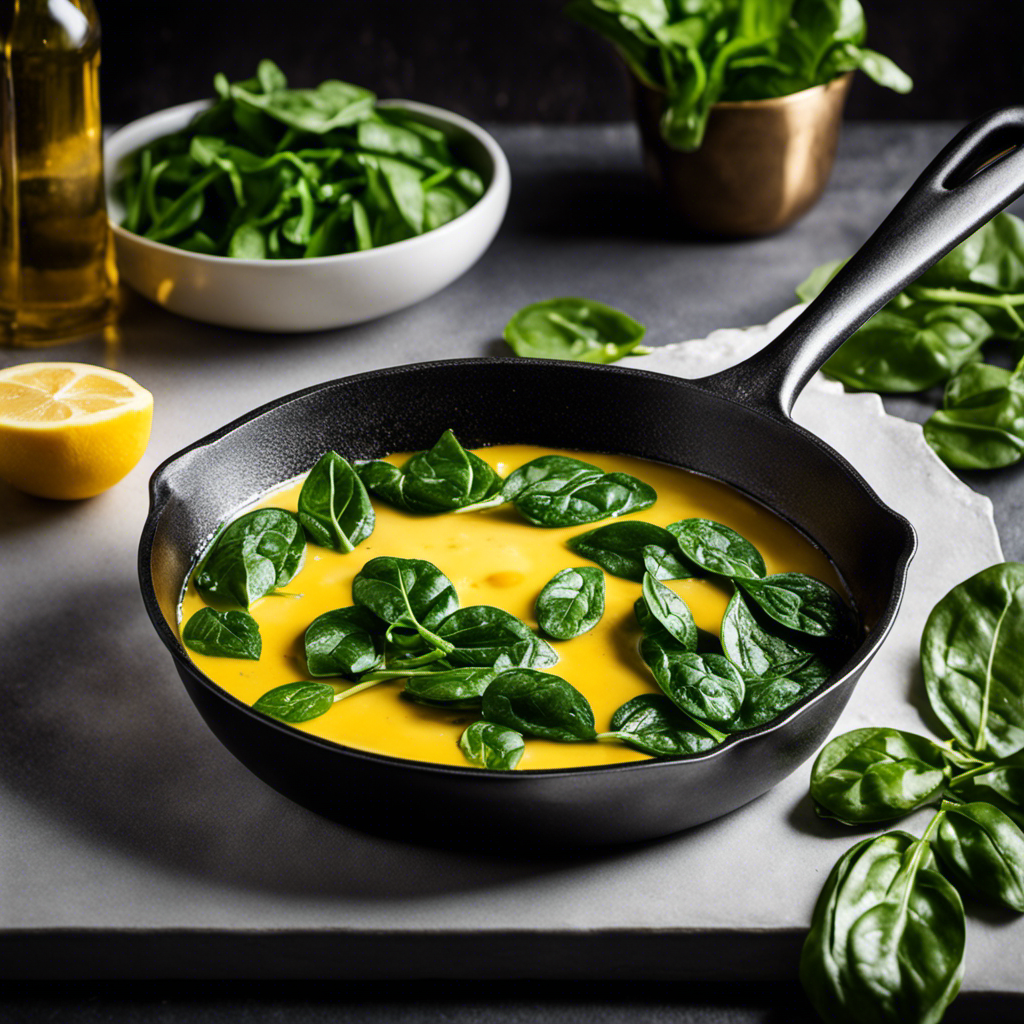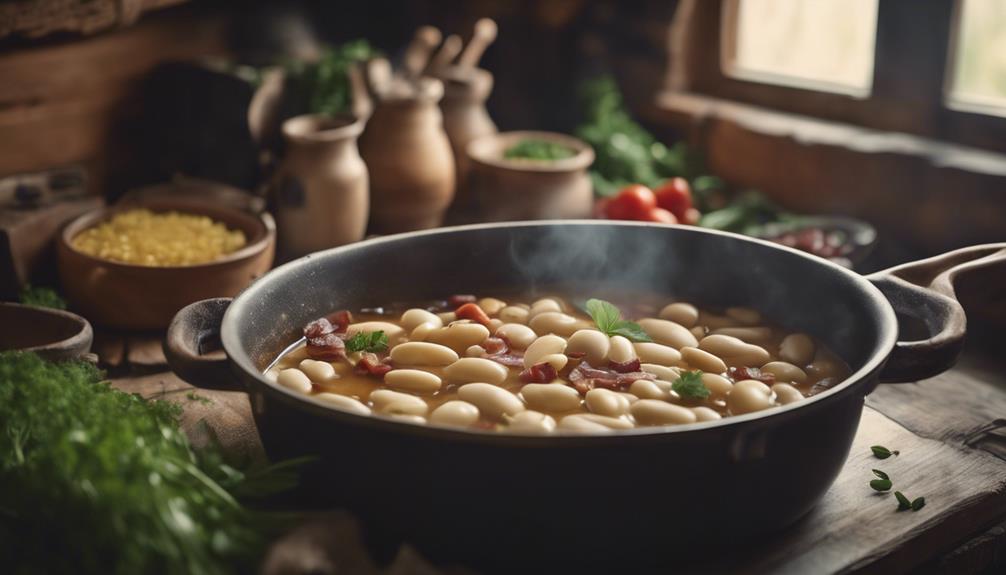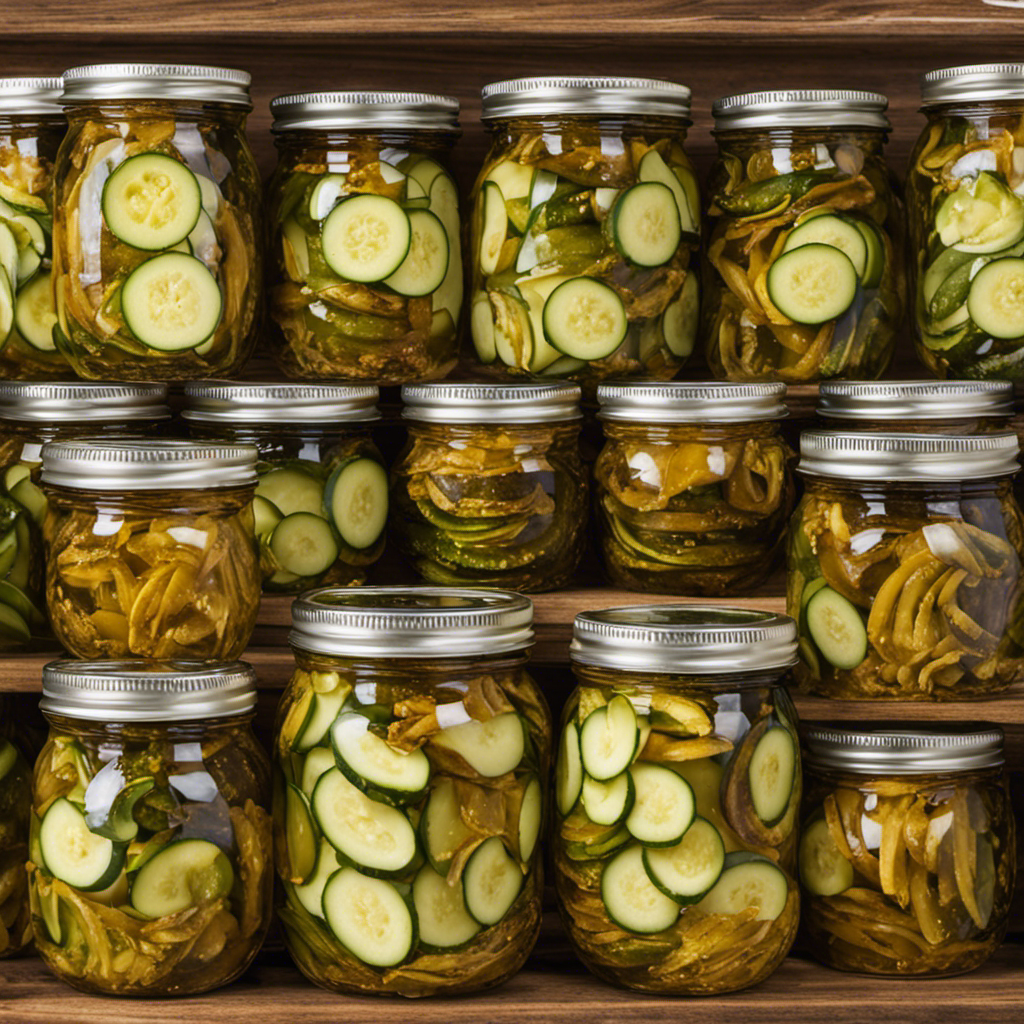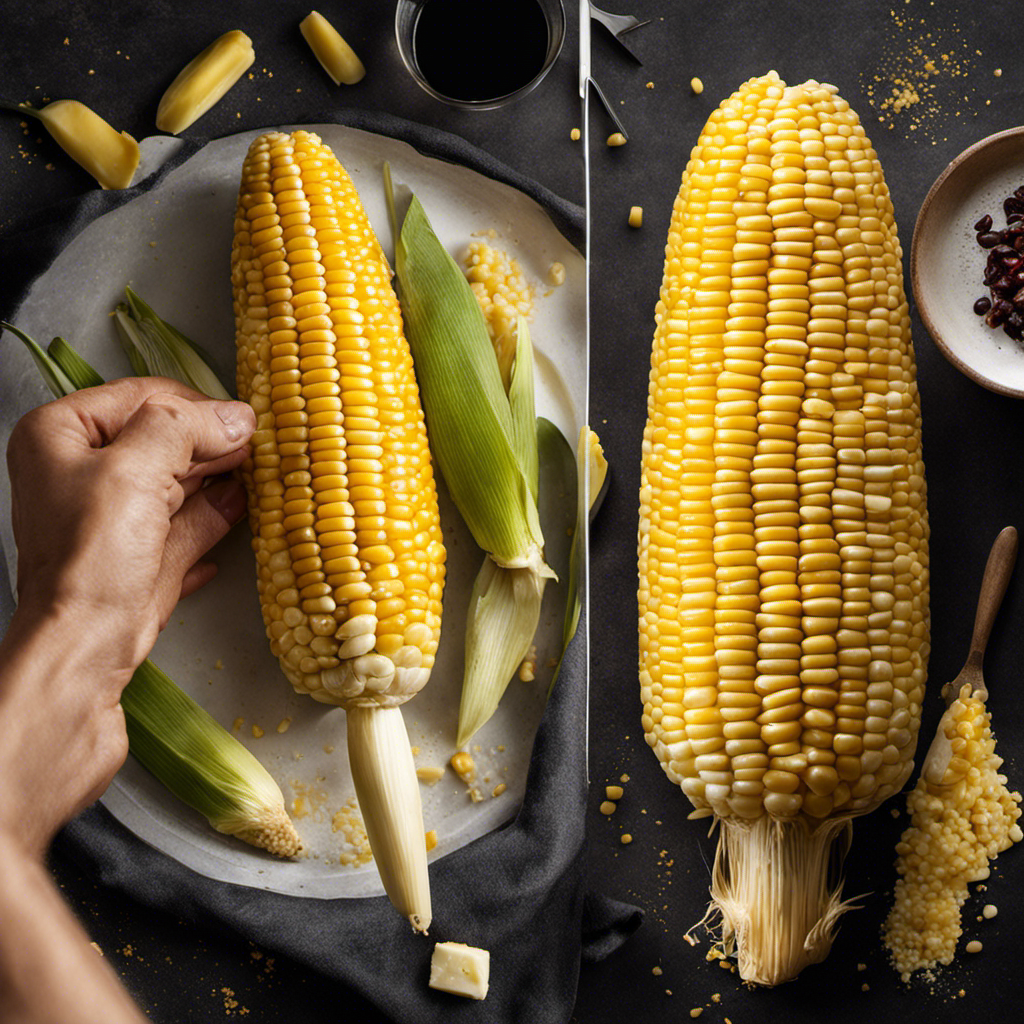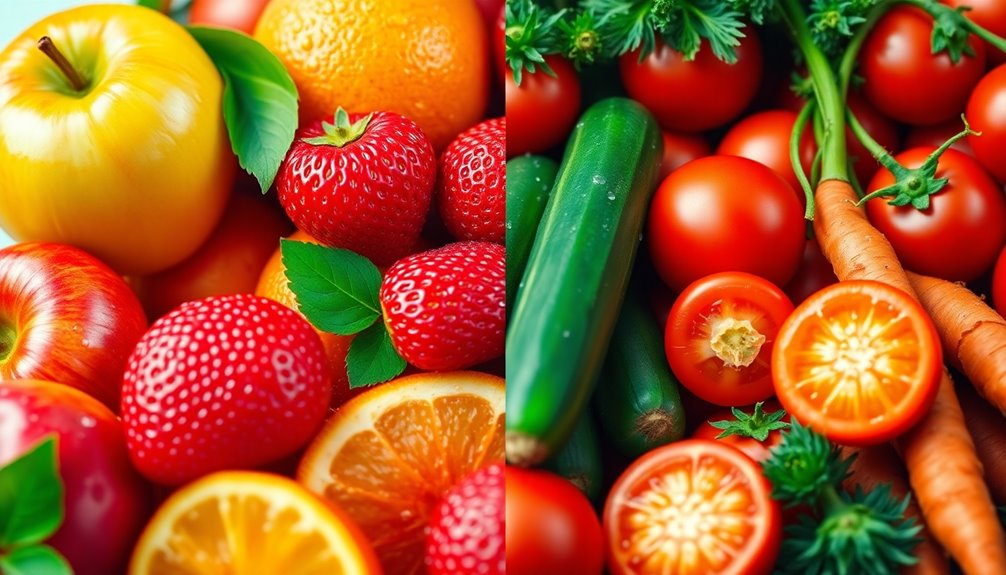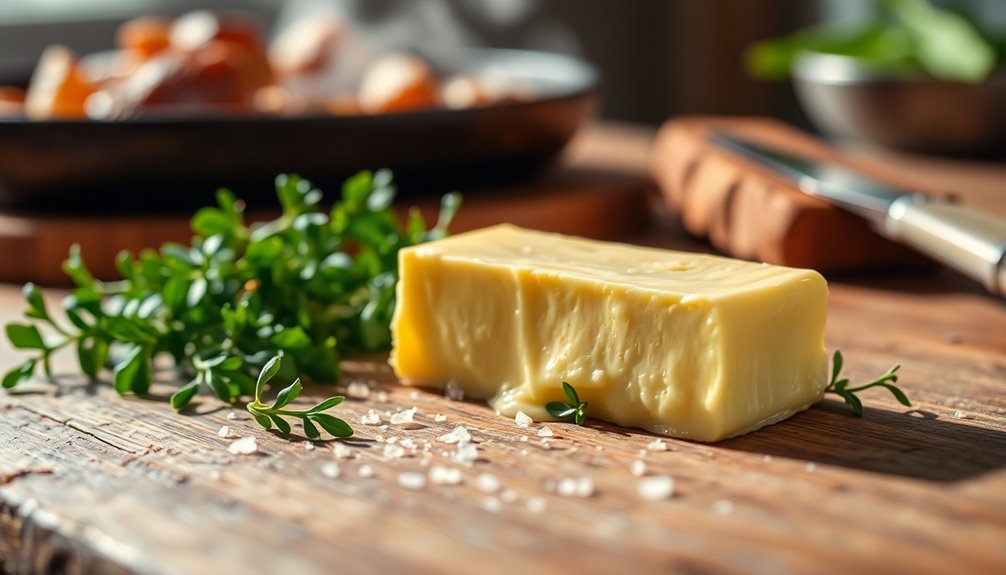I really love cooking spinach in butter because it elevates the rich and creamy flavor of this nutritious green vegetable. In this article, I will share my step-by-step process for creating a delicious dish that can be enjoyed as a side or main course.
From selecting the freshest spinach leaves to melting the butter just right, I’ll guide you through every savory detail.
So, put on your apron and get ready to elevate your spinach game to a whole new level!
Key Takeaways
- Fresh spinach should be bright green and crisp
- Blanching spinach removes bitterness and enhances enjoyment
- Melting butter aids in the absorption of fat-soluble vitamins in spinach
- Spinach can be paired with a variety of main dishes for a flavorful meal
Choosing the Right Spinach
When choosing the right spinach, make sure it’s fresh and not wilted. Fresh spinach leaves should be bright green and crisp. It’s important to check for any signs of wilting or yellowing, as these indicate that the spinach is not as fresh.
To ensure optimal freshness, consider growing spinach in your own garden. Spinach is a cool-season crop that can be easily grown in containers or in the ground. It requires well-drained soil and regular watering.
Now, let’s talk about the nutritional benefits of spinach. Spinach is rich in vitamins A, C, and K, as well as iron, calcium, and fiber. It is low in calories and packed with antioxidants, which help protect the body against diseases.
Incorporating spinach into your diet can boost your immune system and promote overall health.
Preparing the Spinach Leaves
When it comes to preparing spinach leaves, two key techniques for enhancing flavor and texture are blanching and sautéing with aromatic herbs.
Blanching involves briefly boiling the spinach leaves before shocking them in ice water to lock in their vibrant green color and optimize tenderness.
Sautéing the blanched spinach leaves with aromatic herbs like garlic and shallots adds a depth of flavor that complements the natural sweetness of the spinach.
Blanching for Optimal Tenderness
Blanching the spinach in boiling water will ensure optimal tenderness. Here’s how you can do it:
- Bring a pot of water to a boil.
- Add a pinch of salt to enhance the flavor of the spinach.
- Place the spinach leaves into the boiling water.
- Let the spinach cook for about 1-2 minutes until it turns bright green and wilted.
Blanching is an excellent cooking method to preserve the nutrients in spinach. It helps retain the vibrant green color and delicate texture of the leaves. Additionally, blanching spinach before cooking it with butter helps to remove any bitterness and makes it more enjoyable to eat.
Spinach is packed with health benefits, including being rich in vitamins A, C, and K, as well as iron and fiber. By blanching the spinach, you can ensure that you are maximizing its nutritional value while still enjoying a delicious dish.
Sautéing With Aromatic Herbs
To sauté with aromatic herbs, you can add a tablespoon of olive oil to a heated pan and then toss in your desired herbs for a flavor-packed dish.
Sautéing is a versatile cooking technique that involves quickly cooking food in a small amount of oil or fat over high heat. It’s a great way to bring out the natural flavors of vegetables like spinach and enhance their taste.
When sautéing spinach, you can pair it with other vegetables like garlic and onions to add depth and complexity to the dish. The combination of spinach, aromatic herbs, and other vegetables creates a delicious and nutritious side dish or a flavorful addition to your main course.
Now, let’s move on to the next step: melting the butter.
Melting the Butter
When it comes to melting butter, getting the temperature right is crucial. Too hot and the butter will burn, too cold and it won’t melt evenly.
In this discussion, I will explore the ideal butter temperature for melting and also provide alternatives for those who prefer not to use butter.
Additionally, I will share some tips on how to enhance the flavor of your dishes by using herbs in conjunction with butter or its alternatives.
Butter Temperature for Melting
The best way to melt butter for cooking spinach is by using low heat. This ensures that the butter doesn’t burn or become too hot, which can affect the flavor of the dish. Here are four techniques to melt butter effectively:
-
Start with unsalted butter: Unsalted butter has a lower melting point compared to salted butter, making it easier to melt evenly.
-
Cut the butter into small pieces: Cutting the butter into small cubes or slices helps it melt more quickly and evenly.
-
Use a saucepan or a small skillet: A wider surface area allows for faster and more even heat distribution, resulting in a smoother melted butter.
-
Stir occasionally: Stirring the butter helps distribute the heat and prevents it from sticking to the pan or burning.
Alternatives to Using Butter
If you’re looking for a different option, you can try using olive oil as an alternative to butter for cooking. Olive oil not only adds a rich flavor to your dishes, but it also offers several health benefits. It contains heart-healthy monounsaturated fats and is a good source of antioxidants. When using olive oil instead of butter, you can achieve the same level of moisture and tenderness in your dishes.
Another option is using margarine instead of butter. Margarine is made from vegetable oils and can be a suitable substitute for butter in many recipes. It has a similar texture and taste, making it a convenient choice.
By using these alternatives, you can enjoy delicious and nutritious meals without compromising on flavor or texture.
Now, let’s move on to enhancing the flavor with herbs.
Enhancing Flavor With Herbs
To enhance the flavor of your dishes, try incorporating a variety of herbs such as basil, rosemary, and thyme. Herbs not only add depth and aroma to your meals, but they also provide numerous health benefits.
Here are four herb combinations to experiment with:
-
Basil and oregano: This classic Italian duo adds a burst of freshness and a hint of sweetness to your dishes. Perfect for pasta sauces and pizzas.
-
Rosemary and thyme: The earthy flavors of these herbs pair well with roasted meats and vegetables. They bring a savory and aromatic note to your recipes.
-
Cilantro and lime: This zesty combination is commonly used in Mexican and Asian cuisines. It adds brightness and a tangy kick to salsas, marinades, and stir-fries.
-
Dill and parsley: These delicate herbs are often used in seafood dishes, salads, and dressings. They provide a refreshing and herbaceous taste.
Seasoning the Spinach
First, you’ll want to grab some salt and pepper to season the spinach. These basic seasonings will enhance the natural flavors of the spinach. However, there are also other seasoning techniques and flavoring options you can explore to elevate the taste of your dish. Here are some ideas:
| Seasoning Technique | Flavoring Options |
|---|---|
| Sauteing | Garlic, onion, lemon juice |
| Steaming | Lemon zest, nutmeg, red pepper flakes |
| Boiling | Salt, vinegar, bay leaves |
Cooking the Spinach With Butter
After seasoning the spinach, it’s time to cook it with butter. This cooking technique not only enhances the flavor of the spinach but also adds a rich, creamy texture to it. Here’s how you can cook spinach with butter:
- Melt the butter in a skillet over medium heat.
- Add the seasoned spinach to the skillet and toss it gently to coat it with the melted butter.
- Cover the skillet and let the spinach cook for about 3-4 minutes, or until it wilts.
- Stir the spinach occasionally to ensure even cooking.
Cooking spinach with butter not only creates a delicious side dish but also offers some nutritional benefits. Butter contains essential fats that aid in the absorption of fat-soluble vitamins present in spinach, such as vitamins A, E, and K. Additionally, butter adds a dose of flavor to the spinach, making it more enjoyable to eat.
Adding Finishing Touches
Once the spinach is cooked, you can sprinkle it with a pinch of salt and a squeeze of lemon juice for a burst of flavor. This simple addition enhances the taste and brings out the natural freshness of the spinach. Not only does it make the dish more enjoyable, but it also provides numerous health benefits. Spinach is packed with essential nutrients like vitamins A, C, and K, as well as iron, calcium, and fiber. It promotes healthy digestion, strengthens the immune system, and supports bone health. If you’re looking for alternatives to butter, you can try using olive oil or coconut oil to cook the spinach. These options add a delicious flavor while also providing healthy fats. Get creative and experiment with different seasonings and cooking methods to make spinach a regular part of your diet.
| Nutrient | Amount per 100g |
|---|---|
| Vitamin A | 9377 IU |
| Vitamin C | 28.1 mg |
| Vitamin K | 482.9 µg |
| Iron | 2.7 mg |
Serving and Enjoying Your Buttery Spinach
To savor your flavorful spinach, try pairing it with a juicy grilled steak or a tender piece of roasted chicken. Here are some serving suggestions to enhance your meal:
-
Serve the spinach alongside a perfectly cooked medium-rare steak. The rich flavors of the meat will complement the buttery spinach, creating a satisfying and balanced combination.
-
Alternatively, pair the spinach with roasted chicken. The tender and juicy meat will provide a comforting base for the creamy spinach, creating a wholesome and delicious meal.
-
For a vegetarian option, serve the spinach with grilled portobello mushrooms. The earthy flavors of the mushrooms will add depth to the dish, making it a satisfying and hearty vegetarian option.
-
Finally, try serving the spinach as a side dish with a simple grilled fish. The light and delicate flavors of the fish will allow the buttery spinach to shine, creating a light and refreshing meal.
Frequently Asked Questions
Can I Use Frozen Spinach Instead of Fresh Spinach for This Recipe?
Yes, you can use frozen spinach instead of fresh spinach for the recipe. However, keep in mind that there may be some nutritional differences between the two.
How Long Does It Take to Melt the Butter?
To properly sauté spinach, melt the butter over medium heat until it’s fully melted. Be careful not to let it burn. Once melted, add the spinach and cook until wilted, stirring occasionally.
What Are Some Alternative Seasonings I Can Use for the Spinach?
I can enhance the flavor of cooked spinach by using alternative seasonings such as garlic, lemon juice, or red pepper flakes. These options add a delicious twist to the dish and complement the buttery taste.
Can I Use Margarine Instead of Butter?
I prefer using butter when cooking spinach because it adds a rich flavor. Margarine can be used as a substitute, but it may alter the taste. When cooking with frozen spinach, make sure to thaw and drain it properly for better results.
Can I Add Other Vegetables or Ingredients to the Recipe, Such as Garlic or Onions?
Sure, you can definitely add garlic and onions to the spinach recipe. They will enhance the flavor and add some extra depth to the dish. There are different ways to cook spinach with butter, and these additions will make it even more delicious.
Conclusion
In conclusion, cooking spinach with butter is a simple and delicious way to enhance the flavor of this nutritious vegetable. By following the steps outlined, you can create a dish that is both healthy and satisfying.
So why not give it a try? Let the butter melt and dance with the spinach, creating a symphony of flavors that will delight your taste buds. Don’t forget to add your own personal touch and enjoy the buttery goodness of this delightful dish.
Bon appétit!
